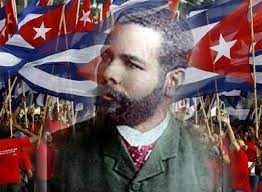
Significance of the life and work of Antonio Maceo y Grajales
Antonio Maceo y Grajales, born on June 14, 1845 in Santiago de Cuba, stood out for his qualities as a combatant for his participation in the war for the independence of Cuba.
And he was also noted for the firmness of his principles.
Precisely José Martí considered that Antonio Maceo was not only a unique combatant with weapons in hand but also stood out for his ideas, for his patriotic convictions.
In a work published in the newspaper "Patria", on October 6, 1893, reflecting a semblance about the brave independence fighter, a few days after having met with Maceo in Costa Rica, Martí described the qualities, sensitivity and firmness of who Cuban history has metaphorically identified it as the Bronze Titan.
Martí summed up the strength of Antonio Maceo's principles in a brief sentence but full of symbolism when he stated: "And you have to pay attention to what he says, because Maceo has as much strength in his mind as in his arm."
He also highlighted what Antonio Maceo's contribution to Cuba could be when he stated: “He will serve it with thought, even more than with courage. Vigor and greatness are natural to him.”
Antonio Maceo, together with members of his family, including his parents, joined the war two days after it began on October 10, 1868.
From a simple soldier he reached the rank of Major General of the Liberation Army.
He came to carry out actions of a political nature of special relevance such as the Baraguá Protest, about which Martí also assured that it was among the most glorious in our history.
On March 15, 1878, in an interview with the Spanish general Arsenio Martínez Campos, who had the purpose of convincing him to accept the Zanjón Pact signed in advance and which meant the end of the war, Maceo ratified his willingness to continue the fight and that he did not agree to lay down his arms without having achieved the independence of Cuba or the abolition of slavery.
He was unable to keep up the fight for a long time due to the adverse conditions he had to face and had to leave Cuban territory.
But even from a physical distance from him, he always kept abreast of the existing situation in Cuba and made clear his willingness to resume fighting.
Initially, together with Máximo Gómez in the 1980s, they conceived a plan that never came to fruition.
But years later when in 1893 José Martí was working hard trying to reorganize the war for the independence of Cuba, and went to meet him in Costa Rica, he ratified his willingness to give his contribution to that effort.
And on April 1, 1895, in an expedition, he arrived in Duaba, in the eastern part of Cuban territory.
Once again he demonstrated his conditions as a combatant and one of the main leaders of the Liberation Army.
He even carried out what was described as a feat or feat from the military point of view, the invasion of an invading column that left from Mangos de Baraguá, in the eastern part, and reached Mantua in the western part of Cuba.
Antonio Maceo fell in combat on December 7, 1896 in the area of San Pedro, in Bauta.
His body and that of his assistant Francisco Gómez Toro could be rescued by the Cuban fighters and finally the remains of both were secretly deposited in Cacahual, in Havana, where there is currently a large monument complex.
The maximum leader of the Cuban Revolution, Fidel Castro, spoke on several occasions about the life and work of Antonio Maceo.
For example, on October 10, 1968, in the commemorative act for the centenary of the beginning of the war for the independence of Cuba, when remembering one of the most transcendental events carried out by Antonio Maceo, in this case on March 15, 1878, the Baraguá Protest, Fidel said: “And it is in those moments —in the moment of the Peace of Zanjón, which put an end to that heroic war— when the most representative character of the world emerges, with all his strength and all his extraordinary size. people, the most representative character of Cuba in that war, who came from the humblest ranks of the people, who was Antonio Maceo.”
Also in 1878, exactly on March 15, when the centenary of the historic Baraguá Protest was commemorated, Fidel also stated: “What can be affirmed is that with the Baraguá Protest it reached its highest point, it reached its climax, the patriotic and revolutionary spirit of our people reached its peak; and that the flags of the country and of the revolution, of the true revolution, with independence and with social justice, were placed on their highest seat.”